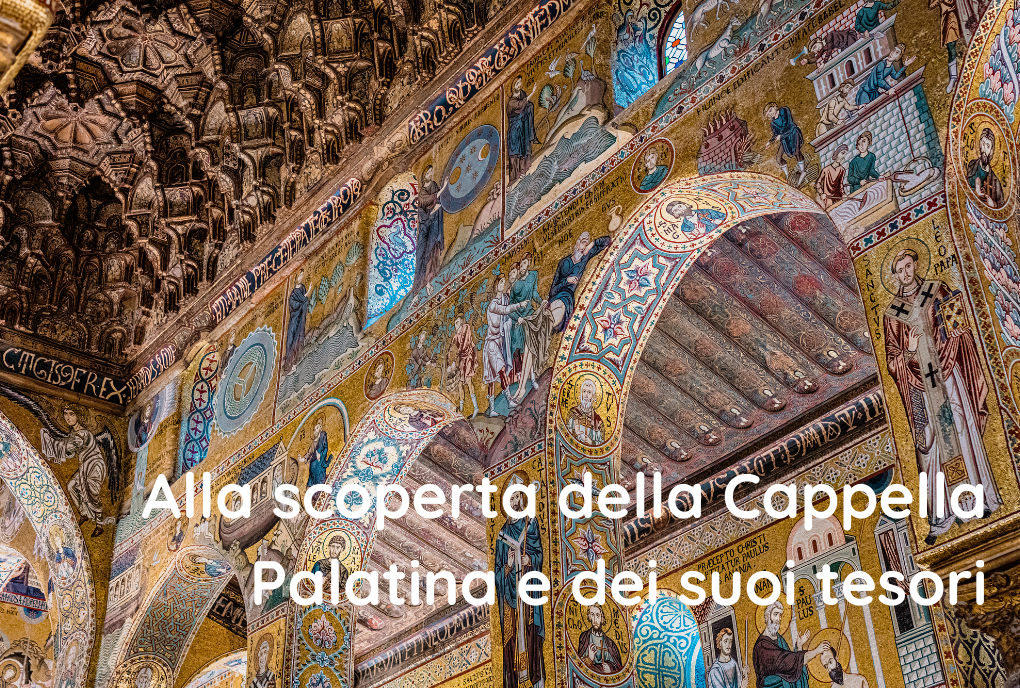
Discovering the Palatine Chapel and its treasures
The Palatine Chapel (or “of the Palace”) is located at the Palace of the Normans in Palermo, built in the oldest part of the city. Commissioned by Roger II of Altavilla, the first Norman king of Sicily, it was used by him as a private chapel in 1130.
Let’s explore the church
His outward appearance was totally different from today. Almost nothing remains of its original facade, as it was incorporated by other, more recent structures. The apse stood isolated within the chapel, facing east in the Byzantine tradition.
Upon entering the church and observing it more carefully, one can recognize the presence of two other small churches. In the western part of the building is a Latin one, divided into three aisles marked by ten granite columns. Toward the east, in the direction of the chancel, one recognizes a Byzantine Christian one with a square plan, surmounted by a hemispherical dome like those found in Greece or Turkey, for example. The decorations and inscriptions found on the walls are in Latin and Greek, testifying to the fact that in the chapel, during the time of Roger II, the two religious components counterbalanced each other and mass was celebrated in both languages.
The Mosaics of the Palatine Chapel
Byzantine mosaics consist of two sheets of glass between which is a thin layer of gold. What you see glittering therefore is real gold! This addition of the gold leaf is a symbolic representation of God’s word and its importance over everything.
The workmanship of the chapel brought people of different origins to collaborate together, such as Arabs, Normans, and Byzantines, who with a policy of tolerance adopted by Roger II were able to build a grandiose edifice.
At the time of the Normans, not everyone could read and write, so the king adopted a language that could be understood by anyone. It was a project of making pictures on the chapel that could represent every story in the Bible.
Every design choice was not left to chance, because the shapes and images were thought of with symbolic meaning. For example, the plan of the chancel is square because it was meant to remind us of the four elements: earth, water, air and fire. An octagon made by obtaining double niches at the corners is observed in the drum. This geometric figure brings back to the meaning of resurrection and universal judgment; it points to an unknown followed by perfection, an ingenious solution to arrive at the circle, that is, a geometric figure that has no beginning and no end and represents God.
The dome is symbolic of the heavenly realm, where Christ is the supreme lord and is surrounded by angels. On its circumference is an inscription, “Heaven is my throne, the earth the footstool of my feet” taken from Isaiah 66.1
The chapel as an inclusion of various ethnicities
As anticipated a few lines above, the chapel was built at a time of great creativity from which the sensibility of different origins can be perceived. This is a masterpiece where the policy of tolerance implemented by King Roger II is acknowledged, so he wanted to show that Eastern and Western cultures could meet in the creation of this work.
The ceiling of the Palatine Chapel
Unique in the world, the chapel’s ceiling is a fatimite a muquarnas meaning stalactites or alveoli.
The self-supporting structure is constructed from thin boards of Nebrodi fir. What can be seen at present are 750 paintings on panels independent of each other made by artists of unknown fame but probably originating in North Africa. And thus is depicted the Quranic paradise, basically where all the pleasures of the senses and spirit that await believers at the time of death are represented. It features trees, monsters, peacocks, eagles, crouching men drinking, musicians and dancers. These are all scenes belonging to secular Islamic iconography, the images depicted of which symbolically represented the wish for a happy life after death.
How to get to the Palatine Chapel?
The Palatine Chapel is located in Independence Square, within easy walking distance of the central station, or the Cathedral and the beginning of Corso Vittorio Emanuele.
You can also get there thanks to buses that stop right there. The lines that come to this point are the 100, 104, 106, 110, 327, 806, 812.
Visiting hours and ticket cost
Mass schedule:
Weekdays 8:30 a.m. – Sundays 10:00 a.m. Info on.
Palatine Chapel
Public opening:
Monday/Saturday from 8:15 a.m. to 5:40 p.m. (last ticket at 4:40 p.m.)
Sundays and holidays from 8:15 a.m. to 1:00 p.m. (last ticket 12:00 p.m.)
by Giulia Nari





